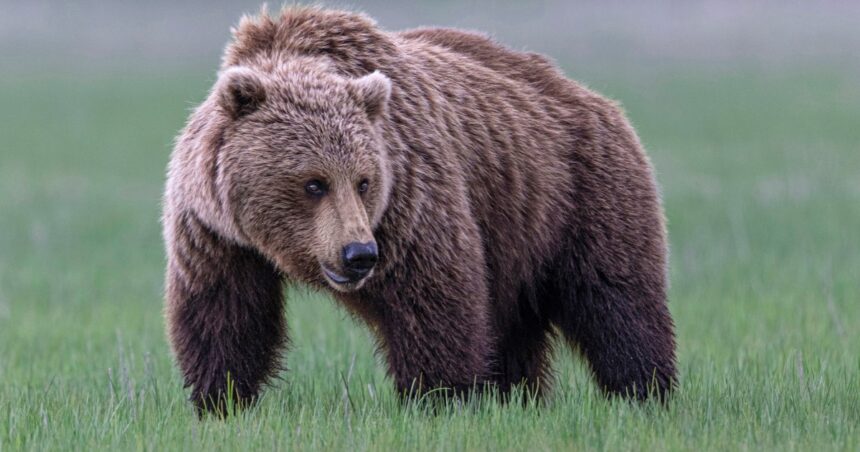
Grizzly bears will be reintroduced to Washington state’s North Cascades mountain range, the federal government said this week — a decision that followed years of bitterly divided debate.
But it may still be years before the creatures step foot in the remote and rugged landscape, given that the complicated process requires trapping, trucking and moving bears by helicopter from British Columbia or northwestern Montana.
“There’s a lot to be done before we could even come up with a timeline,” said Jason Ransom, a wildlife biologist at North Cascades National Park. “For a project like this to be successful, it’s really important you get the planning right.”
The National Park Service and U.S. Fish and Wildlife Service announced Thursday that they hope to build a “founder population” of 25 bears over the next five to 10 years, releasing the animals in remote parts of the forest.
The move would restore a keystone species to the North Cascades, which is one of the best-protected landscapes in the U.S. Grizzlies were once found throughout the region, but thousands were killed for their fur. The bears haven’t been spotted with certainty there since 1996, according to the National Park Service.
The two agencies plan to release three to seven bears each year. The goal is a population of 200 bears within 60 to 100 years.
The North Cascades is one of six areas where federal agencies are pursuing grizzly restoration.
Advocates say the effort will make the overall ecosystem healthier.
“Our culture had a war on these species and we know better now, and this is a chance for us to tell a different story,” said Gordon Congdon, a retired orchardist and conservationist who lives in Wenatchee, Washington, and who has supported the restoration effort. “We think by restoring the grizzly bear, that improves the ecology of the environment, which benefits other animals and benefits the diversity of habitat.”
Ransom said grizzlies turn over soil, spread seeds and can move and thrive in a lot of habitats. As climate change reshapes the environment, bears are expected to fare relatively well.
“I think their ability to move and the really broad spectrum of foods they need bodes well for them. They can be one of the climate change survivors,” Ransom said. “Putting back a species like that builds resilience in an ecosystem in the face of change.”
Opponents, however, worry that bears present a safety risk to people and will stray into lowland areas with farms and livestock. That group includes some farmers and ranchers near the border of the landscape where the bears will make a new home.
For more than a decade, Washington state has struggled to keep wolves from killing livestock and prevent people from illegally harming wolves.
“We already have predator issues in the state. We don’t need another apex predator when we can’t deal with what we have,” said Rachel McClure, a rancher who is the secretary of the Okanogan County Cattlemen’s Association. “We’re busy dealing with wolves. We don’t need to be thinking about bears.”
McClure said she suspects grizzlies will wander from the terrain ecologists choose: “They’re not going to stay where they put them.”
Federal agencies are sensitive to such concerns. But Ransom said release sites would be “in high-quality habitat far, far away from everybody.”
Andrew LaValle, a Fish and Wildlife public affairs officer, said the area of habitat within Washington state is roughly the size of New Jersey, and roughly 85% of it is under federal management.
The federal government has also designated the grizzly bears in this project as a “nonessential experimental population” under the Endangered Species Act, which will give more legal flexibility.
People will be allowed to kill grizzlies to protect humans from bodily harm, and federal agencies will be allowed to relocate or kill the bears, if necessary. In limited cases, with government authorization, private landowners will be allowed to kill grizzlies if they get close to livestock and are a threat.
But lethal action is “not the first tool in the toolbox,” LaValle said.
The bears will be captured in late summer or early fall, according to Ransom, using what’s called a “culvert trap,” which looks like an elongated steel drum with a trapdoor. Once inside, the creatures will be anesthetized, receive a veterinary exam and get fitted for a radio collar so biologists can track their whereabouts.
The bears will be shipped in the traps to staging locations, then helicopters would lift them into the wilderness for release.
Joe Scott, the international programs associate director at Conservation Northwest, said grizzly recovery is slow, challenging work. Female grizzlies typically don’t reproduce until 5 years of age and rarely wander out of their home terrain. Many cubs don’t survive to reach reproductive age.
“As long as it’s taken to get here, it’s just the start of this. The actual implementation is not a slam dunk,” Scott said.
He added that starting with 25 bears should allow the population to ramp up slowly: “It gives a chance for people and bears to get used to each other in a place we haven’t had them for several decades.”

